Martin Edwards's Blog, page 58
May 20, 2022
Forgotten Book - Why Kill Johnny?
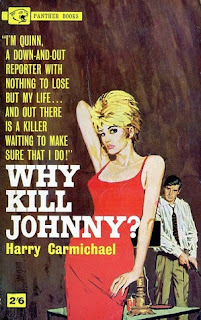
Back in the late 60s, or maybe the early 70s, I watched a TV murder game show, possibly called Who-dun-it?, which I enjoyed and which had a puzzle based on a story by Harry Carmichael. I've never been able to trace any information about this particular show and it doesn't feature in any bibliographies etc relating to Carmichael. So if anyone knows anything about it, I'd be glad to hear from them - at present there are times when I think I must have dreamt it! However, that show did kindle my interest in Carmichael, though I haven't read many of his books until recently, when Catherine Aird generously passed to me some of the Carmichaels in her collection.
One thing I also discovered quite recently was that Carmichael, whose real name was Leo Ognall, was the father of Harry Ognall. Now when I was a trainee solicitor in Leeds, Harry Ognall was a prominent criminal barrister. He subsequently became famous for his brilliant cross-examination of a defence expert witness in the Yorkshire Ripper case and when he became a judge he made an especially notable judgement in the Rachel Nickell/Colin Stagg case, which was controversial at the time - but subsequently vindicated. Incidentally, a little while before his recent death, Harry published a memoir called - guess what? - A Life of Crime!
Anyway, back to his father. Harry Carmichael is one of many authors whom I'd like to have mentioned in The Life of Crime, but there simply wasn't enough space. Under this name, and as Hartley Howard, he was a mainstay of Collins Crime Club from the early 50s to the late 70s and extremely prolific. In some ways he was a post-war descendent of the Golden Age writers, because he was adept at tricky plotting (and I'd also argue that Martin Russell, to a degree, took up the baton from Carmichael in the 70s). He also paid attention to characterisation, although perhaps not with consistent enough success to make a major impression on the critics. Barzun and Taylor were fans, though, and so is the Collins Crime Club expert John Curran, and they are all exacting judges.
Why Kill Johnny? (1954) is a good example of his craft. There is one element of the story - its starting point - that is so strongly reminiscent of Christie's After the Funeral, published the previous year - that I would guess Carmichael borrowed and adapted it for his own purposes. So I figured out one aspect of what was going on, although that didn't spoil my enjoyment, because the two mysteries are - overall - quite different. The writing style owes something to the influence of the American hardboiled writers (as the cover of the US paperback edition above suggests) but it's not badly done. This is a pacy book, with a steadily rising body count and some pleasing plot developments.
May 18, 2022
The Life of Crime - the first review

When you publish a book, you 'd be less than human if you didn't wonder how people were going to react to it. After all the time you've devoted to the writing, it's natural to be anxious about the critical response. This is bound to be true of a novel, a creative work coming from one's own imagination, but it's also true of a non-fiction book - especially some of those I've written (not so much those on legal subjects!), where I've used a novelistic approach, and presented information in the style of a story, as with The Golden Age of Murder, The Story of Classic Crime in 100 Books and now The Life of Crime.
It's important to realise that you can't please everyone - even when you've put years into the writing, as I've done with The Life of Crime. For me, Julian Symons' Bloody Murder is a masterpiece (even though I don't agree with many of his individual opinions) and yet he received endless criticism - and still does - some of it fair, some of it not, as well as innumerable deserved accolades. The Life of Crime is a very different book. But if a book is good enough and makes something of an impression, the fact that some people don't 'get' it or have some sort of axe to grind about it doesn't matter too much. The reality is that not every reviewer takes the trouble to consider what the author was trying to do and to judge the book on that basis, rather than in relation to what the reviewer thinks the book should have been about.
Against that background, I was absolutely thrilled by the very first review of The Life of Crime. Not just because it was so generous, but also because the reviewer, Scott Herbertson, had taken time and care in reflecting on the aims of the book. I'm very glad, too, that he saw no obvious omissions, because the reality is that even when writing a book of this length, it's essential to be highly selective, because the subject matter is so vast and so diverse. To say that I'm encouraged by this initial reaction is a massive under-statement.
And to put a bit of icing on the cake, I've just had word of a lovely review from Kirkus: 'ambitious...a big sweeping text...an impressive range of less well-known authors...a thorough sketch of the genre's origins, its evolutions, and its flexibility in response to cultural shifts...a broad and absorbing overview of one of the most popular and enduring genres of fiction'. So - a great start, and truly gratifying.
May 16, 2022
CrimeFest 2022 - a wonderful weekend
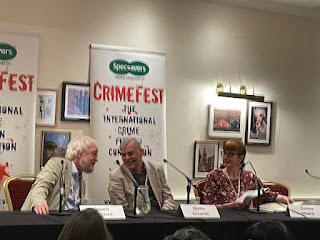
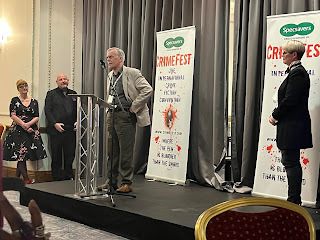
I've just returned from a brilliant weekend in Bristol at CrimeFest 2022. Along with Ann Cleeves, Andrew Child, and Robert Goddard, I was a guest of honour. A huge privilege. When I attended the inaugural CrimeFest , I never imagined this level of recognition; as things have turned out, over the years, CrimeFest has been the scene of plenty of magic moments in my personal crime writing journey. Incidentally, one of the benefits to me of this blog is that some of the detail in the older posts reminds me of great times from the past - as with that 2008 festival. Huge thanks go to Adrian Muller and Donna Moore for all their hard work. They are supported by an excellent team of volunteers and others, including sponsors, and it was great to hear from Dame Mary Perkins that Specsavers intend to sponsor CrimeFest for at least the next three years. And I was presented on stage with a lovely Bristol Blue glass vase as a memento of the occasion.
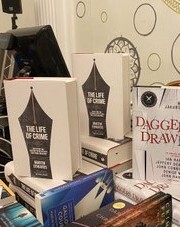
It was thrilling to go into the bookroom and see, for the very first time, a pile of copies of The Life of Crime. And it was even more thrilling to sign copies and see, on the final morning, that every copy on the bookstall had been sold. HarperCollins kindly gave me the chance to invite some old friends to a drinks do (not an actual launch, since the book is technically not published until 26 May) and how pleased I was to spend time with the likes of Simon Brett, Ruth Dudley Edwards, Felix Francis, Cath Staincliffe, Chris Ewan, Robert Goddard, Michael Ridpath, and Linda and Gary Stratmann (special thanks to Gary for acting as event photographer!) among others. Afterwards, HarperCollins hosted a small group of their authors at a private dinner; it was a particular pleasure to sit next to Jane Shemilt, whom I hadn't met before. The previous night I'd had dinner with a group of friends - Kate Ellis, Christine Poulson, and Cath Staincliffe (who was about to learn that she's been shortlisted for the Dagger in the Library) - and I also had a pleasant lunch with Ann Cleeves - as well as coffees with various other friends and fellow authors.
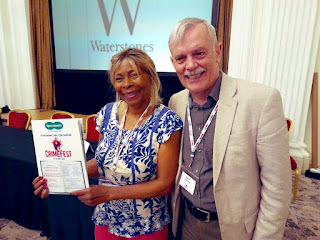
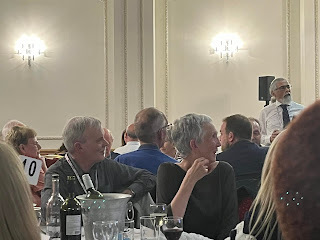
A major highlight came when Donna interviewed Robert and I as Diamond Dagger winners from 2019 and 2020. This was great fun, not least because I've been a fan of Robert's writing for many years. I moderated a panel, 'Suspect Everyone', with Rachael Blok, James Delargy, Victoria Dowd and David Hewson and also took part in a Golden Age panel moderated by Simon Brett, together with Janet Laurence, David Brawn, and TV's Barry Ryan (who made some insightful points about Golden Age stories on television).

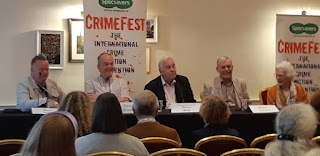
There's never enough time to chat to all one's pals at these events, because the time whizzes by so fast. For instance, I only got a chance to catch up with Yrsa Sigursdottir on my way out of the hotel to catch the train home, but I did enjoy seeing Dolores Gordon-Smith, whom I first met way back at that 2008 CrimeFest as well as Joyanna Lovelock (pictured above), who interviewed me a while back for her podcast. It was a weekend that will stay in my memory for a long time. And as an added bonus, I went to a second hand bookshop in the market and found a rare signed Golden Age mystery for a very modest price. Lucky? You bet.
May 13, 2022
Forgotten Book - Family Skeletons
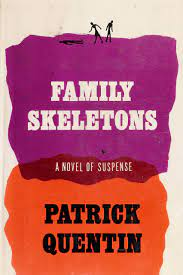
Patrick Quentin, in various incarnations, is an American crime author I've enjoyed reading for many years. The name (and the names Q. Patrick and Jonathan Stagge) conceals a complex set of collaborations, but in the 1950s the brand adorned a final run of books by Hugh Wheeler, writing solo. The last of the books, Family Skeletons, has eluded me until now, but when I had the chance to acquire Dorothy B. Hughes' review copy, I snapped it up.
Hughes was, like me, a Patrick Quentin fan, but I think she probably enjoyed the book rather more than I did. I sense that, by the time this title appeared in 1965, Wheeler was tiring of the game. He'd become established in the world of musical theatre, where great success still awaited him. This story has, as Hughes said, the touch of a professional - especially in the way that suspicion shifts around a pool of possible suspects. But there is something perfunctory about the whole exercise, as if Wheeler's heart wasn't really in it.
The problem is that Lewis Denham, the protagonist, is a rather irritating figure. He's a member of a rich (and even more irritating) family and when he marries in secret, he pretends, for no reason that I could find credible or remotely sensible, that he is not married. Then, when he and his new wife come across a body and realise that she might be a prime suspect, they make matters much worse for themselves by stupidly taking away the corpse and pretending that nothing has happened.
Overall, I felt that this was a story where the characters behaved in the way that they did mainly in order to build the suspense. Yes, contrivance is permissible in a crime story, but it needs to have a touch of believability and we usually need to empathise with at least one of the characters. Wheeler was a talented writer, and he could characterise rather more effectively than he does here. He was also adept at plotting, but I'm sorry to say that, some time before the end, I lost interest in the whodunit twists. This isn't a bad book, but there are certainly a good many better Quentin books than this one. Why was it the last? Probably because Wheeler was smart enough to realise that he'd lost his touch.
May 11, 2022
A Week to Remember
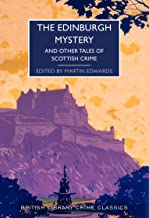
It's not often in my life that I've had a week like this one. Three memorable events already, with a trip to CrimeFest yet to come. Yesterday saw the publication of The Edinburgh Mystery and other tales of Scottish Crime, my latest anthology for the British Library's Crime Classics series. I've included a lengthier intro than usual, discussing Scottish mystery fiction over the years. The stories in the book are an eclectic mix and as ever I hope that there will be something to please all sorts of tastes.
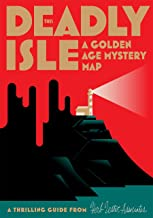
On Monday, Herb Lester Associates produced This Deadly Isle, my Golden Age mystery map. They've done a lovely job of production. I love the cover image and the map itself is a delight. There's information about a variety of GA mysteries, enough to keep dedicated fans who like to see the locations in which stories are set travelling for a long time to come. This really was a fun project.
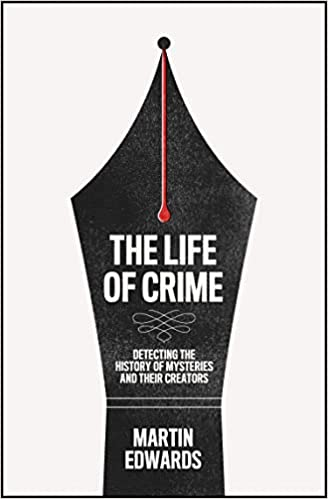
And today, for the very first time, I've held in my hand a copy of The Life of Crime. Actually, it almost needs two hands - it's a big book! Nothing, obviously, compares to holding your own child in your arms for the very first time, but for any author the experience of seeing - at last! - the physical form of the book on which you have been labouring for so long is quite a moment. That's especially true of this book, if only because of the sheer length of time I've been thinking about this project, let alone working directly on it.
To celebrate the imminent arrival of this book (UK publication date is 26 May, and it will hit the shelves in the US at the start of August), I've written various articles for different platforms. One that has just been published is this piece on CrimeTime about some of my favourite writers of books about crime fiction.
How will The Life of Crime be received in the wider world? I really don't know, to be honest. But one thing I can say for sure is this. I'm really happy that I wrote the book, crazily ambitious though the whole project was. And I'm truly thrilled that it's finally seeing the light of day.
May 9, 2022
The Oxford Companion to Crime & Mystery Writing

In the lead-up to publication of The Life of Crime, I was asked last week about my favourite books relating to the crime genre. This prompted me to think back to the appearance of The Oxford Companion to Crime & Mystery Writing, edited by Rosemary Herbert, which was finally published in 1999, but was a very long time in the making.
Let's rewind to the late 1980s. At that time, I was reviewing and writing about crime fiction for a number of publications and also working on the novel that became All the Lonely People. I'd been taken on by an agent, Mandy Little, and I told her of my interest in writing a book about the genre. At that point in my embryonic career, I certainly wasn't foolhardy enough to believe I was equipped to write such a book on my own (a vital catalyst came years later, in a conversation with Andrew Taylor) but I thought I could marshall a book of essays. So I pitched to her the idea of an Oxford Companion about the genre. As luck would have it, Mandy was friendly with Michael Cox of the OUP, and he visited me in Cheshire to discuss the project. Michael was a delightful chap and we had a pleasant afternoon, walking around Lymm Dam in the sun. He later became a very successful novelist prior to a tragically early death. He was enthusiastic about the project, and things were looking good. I was excited.
Then came the news that, unbeknownst to him, OUP in the US had commissioned a very similar book to be edited by Rosemary Herbert. So 'my' Companion bit the dust. This was a shame, especially as it came during a period when a couple of my other pitches met a comparable fate - I was beaten to it by better-known writers - but that's life. It's quite common - a point I make in The Life of Crime - for several authors to have similar ideas at much the same time. I was very pleased when Rosemary asked me to write essays for her Companion. Time went by and requests to contribute further pieces came my way. In the end, I think I contributed more essays than almost anyone else. Later, I met up with Rosemary, and found her delightful company. She even commissioned a new Harry Devlin story for her anthology Murder on Deck.
The main problem with the Companion was simply that it took so long to produce. Robert Barnard and Catherine Aird were in the team supporting Rosemary, and I suspect that all of them were probably frustrated by the delays, which saw several editors at OUP in New York come and go. I began to wonder if the book would ever appear and sadly quite a few contributors, including Julian Symons, who wrote several essays for the Companion, died before it saw the light of day.
However, it was most definitely worth waiting for and I think it's still got a lot to offer the student of crime fiction. There are some wonderful pieces by a range of very well-informed writers - the essay on 'Singletons' by Barry Pike is one example, but I could mention many more. The book earned an Edgar nomination and to me, the only surprise is that it isn't better known today. Rosemary and her team did a great job, in what I suspect were challenging circumstances, and she also produced, in 2003, a slimmed-down version, Whodunit? A Who's Who in Crime Writing in which she generously included an essay about a young novelist called Martin Edwards. So although I never got to edit an Oxford Companion, this particular story led to what, for me, was a happy ending.
May 6, 2022
Forgotten Book - He Who Whispers

He Who Whispers was first published in 1946 and many people rank it as one of John Dickson Carr's finest novels. It features Dr Gideon Fell, my favourite Carr detective, and some crafty work with impossible situations. So why haven't I got round to reading it until now? Too many books, too little time, is the answer. But at last I've read the story - and with considerable pleasure.
The novel opens in post-war Soho. Miles Hammond has been invited to a dinner of the Murder Club, which seems to be modelled to an extent on the Detection Club and also on its true crime counterparts. However, when Miles arrives at the restaurant, neither his host (Fell) nor any of the other Club members are present. Instead, he meets a young woman called Barbara Morell and a French professor called Rigaud. What has happened to the Club members? This preliminary riddle turns out to be quite easily solved: what matters is that the conditions are ripe for Rigaud to tell his two companions a tale about a mysterious murder committed in France before the war.
The story of the murder amounts, in effect, to a fairly long flashback. I did wonder, as I was reading, why Carr did not opt for the greater immediacy of presenting the events as they happened, rather than in retrospect. On reaching the end of the book, I understood why he opted for this method, although I still think it might have been worth structuring the story differently. Fortunately, Rigaud's account is itself quite atmospheric, and the puzzle he presents is intriguing.
I don't want to say too much about the detail of the book, in order to avoid spoilers. The cast of characters is quite small and early on I spotted a point of similarity between this novel and one of Carr's early Bencolin books. This prompted me to come up with a theory about the puzzle that, I'm very happy to say, was completely mistaken. As a result, a crucial plot twist took me completely by surprise - yet it was adequately clued and foreshadowed. Fell isn't as prominent as usual, but this is an entertaining mystery in the classic tradition.
May 4, 2022
The Colonsay Book Festival

I've just returned from a memorable trip to Scotland's west coast and the Colonsay Book Festival. I've been lucky enough to take part in some wonderful book festivals around the world, and I must say that this one ranks among the most enjoyable. Not simply because it's so good to get back into the festival way of life after the pandemic, grand though that is, but because the location - on a small and remote island more than two hours by ferry from Oban - was fantastic and the company and organisation of the festival equally excellent.

I was one of half a dozen speakers and given that two of them have been nominated for the Booker Prize, it felt like very select company indeed. I was interviewed by Neil Hutton, an academic expert in criminal justice, and the time whizzed by during our session. It was good to see two auld acquaintances, Alex Gray and her husband again, and to meet Karen Campbell and hers. The other speakers were John Burns, the poet Robin Robertson, and the novelist and journalist Andrew O'Hagan. Andrew read from his forthcoming 'state of the nation' novel Caledonian Road, a superb extract and enough to make me think this is a novel that might be a Booker winner - you read it here first! The hospitality (with excellent meals at the Colonsay Hotel - strongly recommended) was terrific from first to last and the photo shows the six of us relaxing outside the village hall where the events took place before catching the ferry back to the mainland.





Colonsay is a gorgeous island and luckily the weather was mostly kind, enabling us to to drive round the island and also to wander across the Strand as far as the beach at Oronsay, an island that is paddling distance from Colonsay. Standing stones and lovely, almost empty beaches contribute to the appeal of the landscape and the views take the breath away. The trip fired my interest in the western isles and I hope to return to that part of the world before too long.



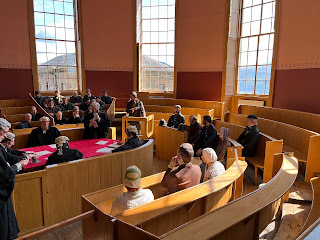


On the way, we stopped off at Inveraray and went round the castle and its grounds and also the ancient and highly atmospheric Inveraray Jail. A sunlit evening walk along the banks of Loch Fyne was quite idyllic. Other highlights of the trip included a look around St Conan's Kirk on the edge of Loch Awe. On the way back, Oban greeted the ferry with a spectacular sunset and next morning there was time to explore Seil Island, which is linked to the mainland by the steep 'Bridge over the Atlantic' - another intriguing place with bags of atmosphere - and also Luss, which claims to be the loveliest village in Scotland. A wonderful trip and I'm very grateful to everyone who worked so hard to make it such a success.







May 3, 2022
Backfire - 1987 film review
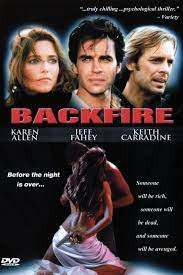
There have been several films called Backfire. The one I'm focusing on today comes from the late 1980s and is, I think, rather under-estimated (one commentator said it should have been called 'Misfire', a harsh verdict from which I dissent). The main trouble with any discussion, however, is that there are some interesting plot twists and it's not easy to avoid spoilers. But I shall try!
Jeff Fahey plays Donnie McAndrew, a Vietnam veteran who is suffering from PTSD as a result of his experiences in the military. He has terrible nightmares and he's also plagued with jealousy because he is upset by a relationship that his attractive wife Mara (Karen Allen) had with a local chap called Jake (Dean Paul Martin, whose last film this was before his tragically early death in a plane crash) ten years ago. Mara tries to reassure him, to no avail.
The McAndrews live in a vast mansion on the coast and are obviously a very affluent couple. If only Donnie could get over his mental health issues, everything would be fine. Or would it? The complications begin a at this point. An important character called Reed (Keith Carradine) comes into the story, but to say too much about him wouldn't be fair on anyone who hasn't seen the film yet.
The script is written by Larry Brand and Rebecca Reynolds, about whom I know nothing, but I think they do a pretty good job in creating a mystery that has familiar ingredients yet also benefits from touches of the unexpected. Yes, tighter direction might have built the suspense a little better, but I felt that Backfire supplied me with good entertainment.
April 29, 2022
Forgotten Book - The Trouble Makers

I've spoken before on this blog about my admiration for the work of Celia Fremlin. She's one of the authors to whom I've given quite a bit of attention in The Life of Crime. Inevitably, it's only been possible for me to talk at length in that book about a selected number of authors whose work I love, but I do see her as influential and important in terms of the development of domestic suspense.
Francis Iles, a very shrewd critic and excellent judge of writing quality, heaped praise on Fremlin's first two books. She didn't need to focus on violence and murder in her stories. Skilful characterisation allowing for the creation of tense situations was her forte. The Trouble Makers, her fourth book, first published by Gollancz in 1963, is a case in point. It presents a picture of suburban life which is as disturbing as it is compelling.
The lead character is Katharine, a harassed mother of three girls whose marriage to Stephen is far from blissful. She takes solace and indeed pleasure from the fact that her friend and neighbour Mary seems to be having a worse time in her own marriage, to an older man called Alan. A number of other women in the neighbourhood who are friendly with Mary also enjoy feeling superior to her.
This is a subtle, slow-burning novel which presents a rather horrifying picture of the interactions between a number of women. Their husbands have considerable failings, but they remain in the background. Fremlin's focus is on the shortcomings of her own sex. To what extent her views were influenced by her own experiences, I don't know, but the outcome is truly chilling. Fremlin describes a way of life which in some respects now belongs to the distant past, but there is something timeless about her portrayal of the casual cruelties of which seemingly decent people are sometimes capable.



